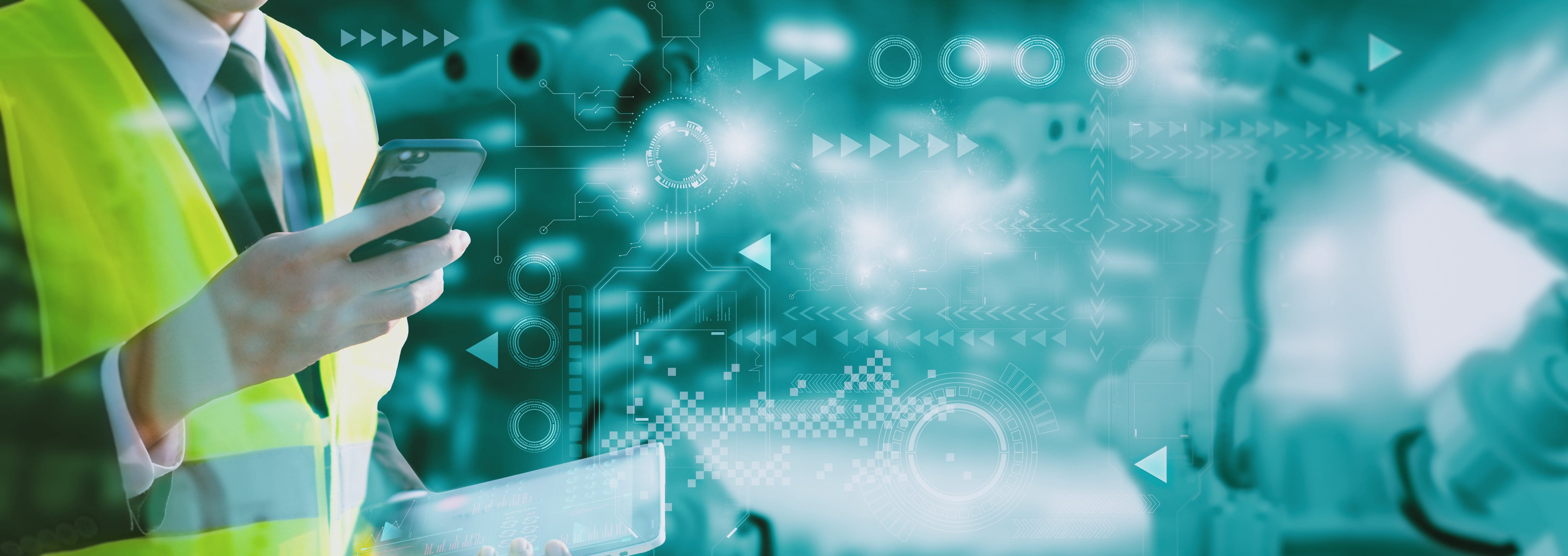
Automation will solve many problems—but not without people supporting it.
Derrick Colyer, Business Development Manager at E Tech Group, shares his insights in this latest Food Engineering article on automation trends. Derrick discusses the role of AI in food manufacturing, and why digital transformation needs to come first.

What’s Going on with Automation in the Food & Beverage Industry?
The food and beverage industry has been one of the slowest to adopt new technologies—and maybe that’s a good thing. The auto, chemical and petroleum industries, for example, have served well as testbeds for new automation technologies.
Meanwhile, food and beverage has benefitted from all the trialing and proving of “bleeding-edge” systems such that the buzzwords we’ve used for the last few years—e.g., “digital transformation,” AI/ML, “digital twin” and Industry 4.0—are becoming everyday terms that describe technology we now rely upon to be competitive in today’s changing world of consumer tastes.
What Do the Automation Engineers & Integrators Have to Say?
So, I asked system integrators, engineering houses and automation suppliers what their food processor clients perceive to be the three to five key trends/issues in automation today, and how processors are taking advantage of these automation trends. After tabulating the results, the top five trends cited were:
- Visualization (including enterprise, platform, machine and remote visibility)
- Data collection and analytics plus AI/ML
- Digital transformation
- Robotics and automated material handling (extending to warehouse automation)
- Security/cybersecurity
Effective Automation & Visualization Go Hand-in-Hand
When I asked integrators and system suppliers what are the key trends affecting food and beverage processors, their most-often cited responses were enterprise visualization/machine visibility/remote visibility—and tied with visibility were the tools that provide the instrumentation food processors use to achieve the visibility; that is, analytics/data collection/AI/ML, etc. As in IFR flying, without sensor data to power the visualization/instrumentation system, you might as well be flying blind.
What drives the need for enterprise visualization? “The ability to monitor, harvest and analyze data allows manufacturers to be more responsive to a marketplace that demands flexibility while dealing with supply chain and lean manufacturing issues,” says Dean Elkins, Sr., director, advanced automation at Gray Solutions, a Gray Company.
While there’s no question visualization at any level will help processors get a handle on their process, many older facilities suffer from two problems caused by their age: lack of connectivity and obsolete equipment. These problems require experienced system integrators that understand the food and beverage industry, as an upgrade and integration to an aging, piecemealed automation system takes creativity and knowledge on the latest technology.
Learning AI for Better Industrial Data Analytics
With continuous industry growth comes the need for food and beverage manufacturers to scale production without sacrificing quality or compliance. And without utilizing tools like AI, the blind spots in a control system’s ability to collect and report data can cause a company to hemorrhage money in lost production time and more piecemeal repairs.
It’s time for new tools, says Bob Rice, Ph.D., Vice President of Engineering at Control Station Inc. “The age-old race continues for manufacturers to gain a competitive advantage by increasing throughput and reducing costs. If viewed through a Six Sigma lens, then it becomes clear that most of the industry’s potential gains have been realized using traditional tools—the low hanging fruit has already been picked.
“Now those in the food and beverage industry are adopting a new set of analytical tools that promise to uncover non-obvious opportunities for optimization. Those tools require data to be served up from numerous individual production facilities so it can be accessed and analyzed centrally.”
“With economic downturn, the need to analyze and optimize existing facilities is important,” says Roger Kredit, Lead Control Systems Developer at CRB. The focus is to be able to provide automation to self-tune using artificial intelligence (AI) to increase efficiencies of production. If AI isn’t available, providing the ability to capture and visualize is essential to KPI information. Automation helps engineers and subject matter experts realize and address issues.
The Real Meaning of “Digital Transformation”
The term, “digital transformation,” which was tied for second place in our survey, seems an overworked term that has lost some of its meaning—suffice to say it can probably serve as a wrapper for everything covered in this article. After all, isn’t this what we seek when we have applied technology to a facility and its methods, process and operation?
Digital transformation must happen before a company can consider things like AI, wireless tools, lack of connectivity, etc., says Colyer. “Digital transformation must be planned for and also must be included in your operations plans for your personnel, too. A successful digital transformation enables the right data to get to the right person at the right time! And then, the person must be equipped to utilize that data for the benefit of the organization.”
Digital transformations are a must in any industrial automation design, as it lays the foundation to apply more advanced tech that can transform a factory’s capabilities. Control system integrators play a key role in guiding manufacturers through this transition by providing turnkey automation systems that are flexible and scalable.
Automated Material Handling to Handle Labor Shortages
According to an ARK INVEST research study updated in 2019, the cost of an industrial robot in 1995 was $133,382 in 2017 dollars. The study projects that the same robot will cost less than $11,000 per unit in 2025. Combined with advances in machine learning and computer vision, robot unit sales are projected at 3.4 million, up roughly 380,000 recorded in 2017.
In our survey of interviewees, robotics and automated material handling ranked second, tied with digital transformation. Robotic automation has recently been providing food manufacturers the infrastructure that provides the flexibility to handle a wide variety of goods in the widest range of combinations and in the shortest possible time, says Ali Raja, vice president – consumer market segments, ABB Robotics.
The three most pressing trends in automation are designed to meet the challenges of today’s economy, says CRB’s Kredit. The first is to use automation—like autonomous solutions and robots—to supplement or offset employee shortages. Automation simplifies processes and takes on basic tasks to help cover gaps where finding employees is hard.
Cybersecurity is the Key to Increased Implementation
Security/cybersecurity came in at number three in our open-ended poll. Security is driven by both regulatory needs and increasing visibility of vulnerabilities in system and networks. Security issues can impact IP, product safety and worker safety, making these areas mission critical, says Alan Stanfill, Director of Digital Transformation at Gray Solutions, a Gray Company.
“Of the trends I’ve been keeping an eye on recently, the most important is cybersecurity,” says Raymond Berning, Automation Manager at Interstates, a CSIA Certified Member. “Cyber threats are continuously increasing, and food processors are understandably concerned about keeping their facilities safe and protecting quality control.”
No one is exempt from a cyberattack, says ICONICS’ Ballouz. “Cyber criminals are targeting food and beverage organizations—and not just large organizations but also smaller ones—especially their supply chains. Organizations are using automation to gain the visibility needed to ensure that those connected to their networks are not a liability, particularly since personnel use tablets and other mobile devices on the manufacturing floor which can be potential weak points in security.”
Everything is Connected… Or it Should Be
Our survey brought to light the interconnected nature endemic to automation advancement in food and beverage manufacturing. We can’t achieve proper cybersecurity design without achieving sufficient visualization. We can’t make the best use of any visualization without just enough data analytics, and we can’t properly integrate all these facets of an automation system without a digital transformation.
The food and beverage industry may not be able to wait in the wings while other industrial sectors test out new automation technology anymore. Rapid growth and logistical obstacles require manufacturers stay on their toes; you may need to expand a production line’s capabilities or throughput on a tight timeline and without additional personnel.
Control system integrators and automation professionals that specialize in industrial food automation will play an integral role in changing the industry’s view on automation, and helping them overcome the challenges that come with implementation. It will set the industry, and each manufacturer, up for success.
The original version of this article was published by Food Engineering Magazine.